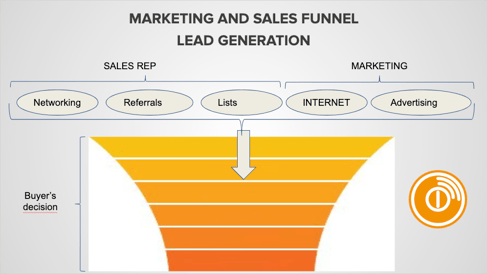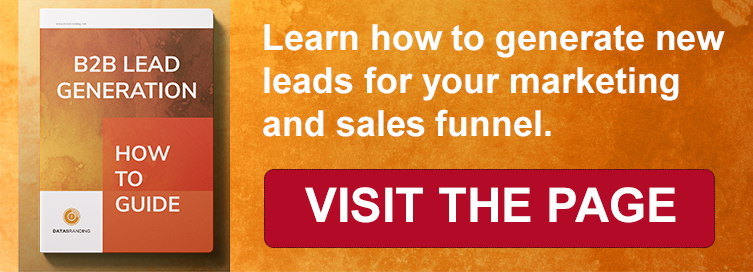
It is marketing's job to always find ways to generate new potential customers in all the different channels that there are. In this digital era, there is an even more efficient way to achieve this, based on an Inbound Marketing Lead Generation strategy. How does this work? You're about to find out!
Attracting Prospects
There are several sources with which we can attract future customers. In the past, people came to our solution thanks to traditional advertising or to a sales representative who kept prospecting in order to find the person who needed our solution. So the attraction strategies were divided by the source or channel in which they were made.

Sources or Channels to Attract Prospects
This sources traditionally were:
Networking
Networking is the fostering of the company's personal relationships or public relations in order to increase the number of people who know it, done in a 1 to 1 way. This is the best and most solid strategy. A word of mouth recommendation is worth much more than anything else.
However, it takes too long to grow with this technique only and it's hard to know
- How long it will take until it works
- The exact impact that it'll have on creating future clients
Within these strategies we find: PR events, personal relationships, acquaintances with industrial chambers and expositions or trade shows.
Referrals
In a perfect world, we should have our clients recommend our brand, product or service, to their acquaintances yet, it's delicate to ask a customer to do so. This strategy has to be carried out with the perfect timing so that the client would actually want to refer our brand to his/her acquaintance.
The perfect time to do this is when a client is satisfied with our service otherwise, we'll never get the much wanted reference.
Lists or Prospecting
In the past, salespeople were given lists of contacts, starting with the yellow pages or industry lists, to emailing lists and telephone numbers. They then proceeded to make these calls, which were called cold calls, to see if these people would be interested in the company's solution.
As we all know, this strategy has become less and less effective and, it's been abused of so many times, that we are no longer willing to receive calls from strangers or spam emails.
This technique has evolved with social networks information. We can now learn about the context of our contacts and know if they need our product or not. We can focus our prospecting only those who actually have the problem that we solve - and thus, be less invasive to them - and discard those who don't need it.
Prospecting is still being done but it's been adapted to this new strategy, taking advantage of information technology.
Traditional Advertising
We have all been exposed to these kinds of stimuli and releases on radio, press and television. The problem is that we are increasingly less exposed to traditional media and we are not willing to be interrupted while consuming the content that we're indeed interested in.
We don't like receiving SPAM communication from someone we know nothing about, with a solution that we aren't interested on at that moment.
And the new ones are:
Internet
Access to information has changed everything and it's the most powerful and massive source to attract prospects. We all look for information by asking questions to internet search engines (such as Google) which in turn, offer the following results:
- Organic Results
These are the results for which you don't have to pay to be offered as an answer. This "best answer" place is then achieved when search engines find our content as the best possible answer to the question that people asked. So content marketing has to focus on the questions that people ask, offering the best possible answer to them.
- Paid Results (ads)
You pay for keywords. This means that if someone, when searching on an engine (say Google), types one of the words for which we have paid, our result (since we paid for it) will appear at the top of the list of answers. There are different advertising strategies that can be adapted within this kind of model.
Social Networks
Finally, social networks play an important role in maintaining and attracting an audience that is interested in the topics of our industry or in the solutions offered by our company.
With these means, we can easily attract visitors who will become PROSPECTS or LEADS.
What's a Lead or Prospect?
A lead is a person who has shown some interest in the company's products or services.
We know a person is interested when we see that enough trust has been generated so that they feel free to get in touch with us by:
- Entering our store
- Giving us a phone call
- Writing to us on our social networks
- Leaving comments on our blog posts
- Downloading a file from our website
- Filling in a form with their contact information
Some people may sho interest during a cold call as well but, we will here focus on what happens in the digital world.
Lead Generation
It's the process by which we help a lead move forward in his buying decision while we also rate his degree of interest on us.
If a person wants to solve a problem or find a solution, and makes some research regarding this problem, companies should help this person by offering their solution to him based on content that will help him understand how does it work, how to buy it and which are his options. This is how we help our customer move forward in his buying process.
A person who advances more and more in his research, shows that has a greater commitment to solve his problem. This is how we can be almost certain that he will become a potential client.
Lead Generation Process
It's the process of attracting people so that they willingly share their contact information with us. By doing so, we'll be able to keep in touch with them and interest them more and more in our solution.
Example of this process:
- Prospect looks for information on Google
- He clicks on an article that seems to have the information he's looking for
- He reads the article which also offers premium content that will provide even more information on the topic. This content is sent to him in exchange of his contact information, which he'll share with us by filling in a form. The pages that show this form are called Landing Pages.
- A content nurturing campaign gets started and the prospect receives more and more information on the topic that he showed to have some interest in.
- If he keeps coming back for more information, it means that he is prospect that is actually interested in our content/offer and starts to be qualified as such by the company.
- The prospect gets in touch with a sales rep. If we have enough context about the problem that the prospect is trying to solve, based on the content that the prospect has seen, a sales rep may get in touch with him and start a conversation.
- The client fully understands our solution and decides whether to use it or not.
Prospect Qualification
Depending on the degree of interest and involvement that the prospect shows, and according to several stages, the prospect is qualified as:
- Prospect. Someone who shows interest and shares his contact information with us.
- Marketing Qualified Lead (MQL). The marketing staff evaluates how many pieces of content has this person interacted with and notifies the sales area so they contact him. They also assess whether the client fits the profile that we are looking to serve.
- Sales Qualified Lead (SQL). Sales staff assesses whether the customer has the need for our product/service or not.
- Opportunity. The client has formally requested a quote, that is equivalent to a deal that can be related to a certain amount of money.
- Client. The client decides to buy the product or service.
- Promoter. If the client is fully satisfied, he'll turn into your company's promoter.
We can help you understand more about how to measure and get results from your marketing funnel through our experience in doing great strategies. Visit the next page to learn more.
Subscribe to our blog at the top of this page to receive more articles with marketing and sales ideas.

